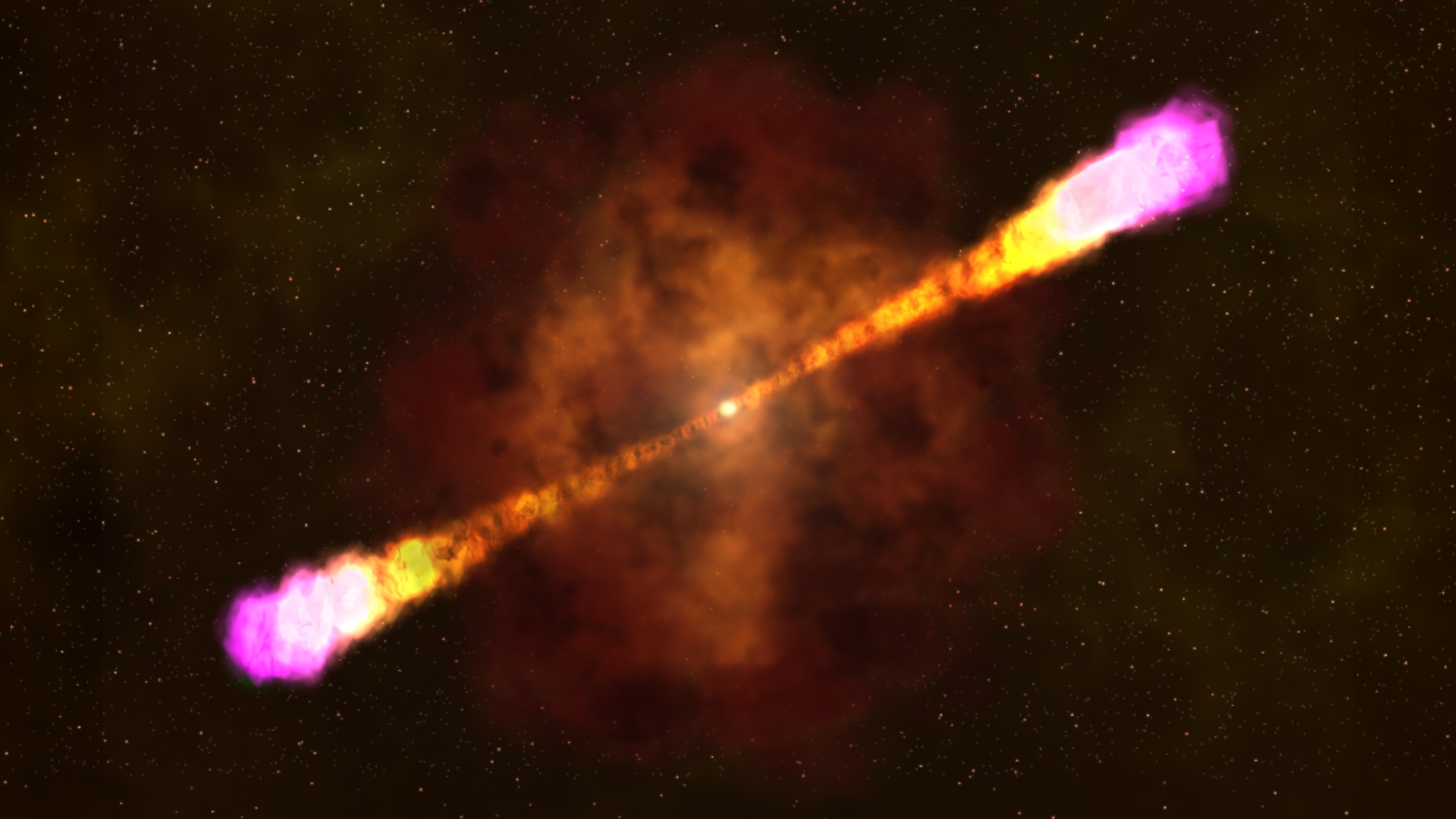NASA's Swift Catches its 1,000th Gamma-ray Burst

Labeled image. GRB 151027B, Swift's 1,000th burst (center), is shown in this composite X-ray, ultraviolet and optical image. X-rays were captured by Swift's X-Ray Telescope, which began observing the field 3.4 minutes after the Burst Alert Telescope detected the blast. Swift's Ultraviolet/Optical Telescope (UVOT) began observations seven seconds later and faintly detected the burst in visible light. The image includes X-rays with energies from 300 to 6,000 electron volts, primarily from the burst, and lower-energy light seen through the UVOT's visible, blue and ultraviolet filters (shown, respectively, in red, green and blue). The image has a cumulative exposure of 10.4 hours.
Credit: NASA/Swift/Phil Evans, Univ. of Leicester
NASA's Swift spacecraft has detected its 1,000th gamma-ray burst (GRB). GRBs are the most powerful explosions in the universe, typically associated with the collapse of a massive star and the birth of a black hole.
A GRB is a fleeting blast of high-energy light, often lasting a minute or less, occurring somewhere in the sky every couple of days. Scientists are looking for exceptional bursts that offer the deepest insights into the extreme physical processes at work.
Shortly before 6:41 p.m. EDT on Oct. 27, Swift's Burst Alert Telescope detected GRB 1,000 as a sudden pulse of gamma rays arising from a location toward the constellation Eridanus. Astronomers dubbed the event GRB 151027B, after the detection date and the fact that it was the second burst of the day. Swift automatically determined its location, broadcast the position to astronomers around the world, and turned to investigate the source with its own sensitive X-ray, ultraviolet and optical telescopes.
Astronomers classify GRBs by their duration. Like GRB 151027B, roughly 90 percent of bursts are of the "long" variety, where the gamma-ray pulse lasts more than two seconds. They are believed to occur in a massive star whose core has run out of fuel and collapsed into a black hole. As matter falls toward the newly formed black hole, it launches jets of subatomic particles that move out through the star's outer layers at nearly the speed of light. When the particle jets reach the stellar surface, they emit gamma rays, the most energetic form of light. In many cases, the star is later seen to explode as a supernova.

Unlabeled image. GRB 151027B, Swift's 1,000th burst (center), is shown in this composite X-ray, ultraviolet and optical image. X-rays were captured by Swift's X-Ray Telescope, which began observing the field 3.4 minutes after the Burst Alert Telescope detected the blast. Swift's Ultraviolet/Optical Telescope (UVOT) began observations seven seconds later and faintly detected the burst in visible light. The image includes X-rays with energies from 300 to 6,000 electron volts, primarily from the burst, and lower-energy light seen through the UVOT's visible, blue and ultraviolet filters (shown, respectively, in red, green and blue). The image has a cumulative exposure of 10.4 hours.
Credit: NASA/Swift/Phil Evans, Univ. of Leicester

This illustration shows the positions of 1,000 Swift GRBs on an all-sky map oriented so that the plane of our galaxy, the Milky Way, runs across the center. Bursts are color coded by year, and the location of GRB 151027B is shown at lower right. An annual tally of the number of bursts Swift has detected appears below the label for each year. Background: An infrared view from the Two Micron All-Sky Survey.
Credit: NASA's Goddard Space Flight Center and 2MASS/J. Carpenter, T. H. Jarrett, and R. Hurt

This illustration shows the positions of 1,000 Swift GRBs on an all-sky map oriented so that the plane of our galaxy, the Milky Way, runs across the center. Bursts are color coded by year, and an annual tally of the number of bursts Swift has detected appears below the label for each year. Background: An infrared view from the Two Micron All-Sky Survey.
Credit: NASA's Goddard Space Flight Center and 2MASS/J. Carpenter, T. H. Jarrett, and R. Hurt

This illustration shows the ingredients of the most common type of gamma-ray burst. The core of a massive star (left) has collapsed, forming a black hole that sends a jet moving through the collapsing star and out into space at near the speed of light. Radiation across the spectrum arises from hot ionized gas in the vicinity of the newborn black hole, collisions among shells of fast-moving gas within the jet, and from the leading edge of the jet as it sweeps up and interacts with its surroundings.
Credit: NASA's Goddard Space Flight Center
An animated version of this diagram is available here.

Alternate image, labeled. GRB 151027B, Swift's 1,000th burst (center), is shown in this composite X-ray (magenta), ultraviolet and optical image.
Credit: NASA/Swift/E. Troja

Alternate image, unlabeled. GRB 151027B, Swift's 1,000th burst (center), is shown in this composite X-ray (magenta), ultraviolet and optical image.
Credit: NASA/Swift/E. Troja
For More Information
Credits
Please give credit for this item to:
NASA's Goddard Space Flight Center
-
Science writer
- Francis Reddy (Syneren Technologies)
-
Visualizer
- Francis Reddy (University of Maryland College Park)
-
Graphics
- Francis Reddy (University of Maryland College Park)
-
Scientists
- Eleonora Troja (University of Maryland College Park)
- Neil Gehrels (NASA/GSFC)
-
Illustrator
- Scott Wiessinger (USRA)
Release date
This page was originally published on Friday, November 6, 2015.
This page was last updated on Wednesday, May 3, 2023 at 1:49 PM EDT.

